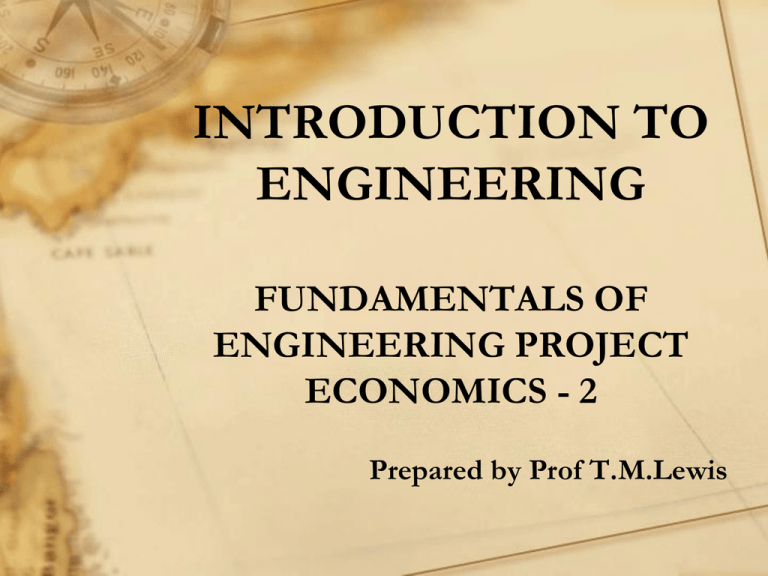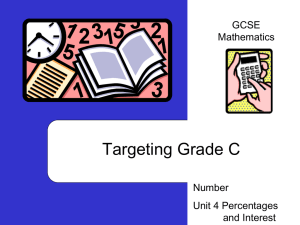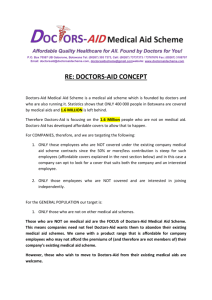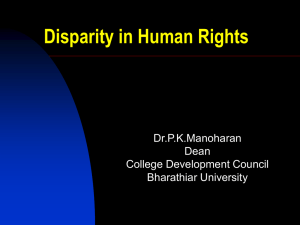Pre-Engineering Introduction to Engineering Lecture 2
advertisement

INTRODUCTION TO
ENGINEERING
FUNDAMENTALS OF
ENGINEERING PROJECT
ECONOMICS - 2
Prepared by Prof T.M.Lewis
Location of Notes – to be updated
• http://www.eng.uwi.tt/depts/fac
ulty/ugrad/courses/engr0300/eng
r0300.html
Effect of Time – Interest Rates
• Interest is the amount that has to be paid for the use of
borrowed money, and it is a rate (usually a percentage)
for a period of time (usually a year), and so interest is a
measure of the time value of money.
• Within the level of accuracy normally required for
engineering projects, interest rates can be assumed
proportional to the length of time period:
• 12% per annum = 1% per month
• 1% per month = (1/30)% per day
Time Value of Money
• Cash inflows to a project are normally treated as
positive (+) whilst cash outflows are negative (-).
• The net cash flow during any time period is simply
the difference between the cash inflows and the
outflows, and it may be either positive or negative
• For an engineering project, receipts (benefits) and
expenditures (costs) are generally compared at the
start of the project - this is ‘the end of year zero' or
‘the start of year 1’ – so they are all usually converted
to their equivalent Present Value.
Time Value of Money
• Which is better?
Now
-$1,000
-$5,000
-$10,000
End yr 1
+$500
+$1,000
+$9,000
End yr 2
+$500
+$2,400
+$6,500
End yr 3
+$500
+$8,000
+$500
Cash Total +$500
+$6,500
+$6,000
• How can you tell which gives the best return?
• By converting them all to equivalent values.
Present Value
• All cash sums can be converted to an equivalent
value by working out what sum would have to
be 'invested' now (start of year 1 = end year 0) at
the going interest rate to give that specific sum
at that specific time in the future.
• The equivalent sums at the start of year 1, are
Present Values (P)
• The process of converting an amount to its
equivalent at an earlier date is known as
discounting, and the interest rate involved is called
the discount rate.
SIMPLE INTEREST
• Simple Interest is where the interest on some
capital (present) sum or principal is not
reinvested to earn more interest on itself.
• Where: i = interest rate; I = Interest earned; P = Present
sum; F = Future sum
• Interest earned in one year I1 = P.i
• Interest earned in 2 years I2 = Pi + Pi = P.2i
• Interest earned in n years In = P.ni
SIMPLE INTEREST
• At end of n years the future sum will be:
• F = P + In = P + P.ni = P(1+ni)
• F = P(1+ni)
• Alternatively, by rearranging the equation, we can get
an expression for the present value given the future
sum.
• P = F/(1+ni)
• Simple interest is rarely used in practice
• Normally it is compound interest that is required.
COMPOUND INTEREST
• Where the interest each year is reinvested to earn more interest
on itself.
• Again where: i = interest rate; P = Principal (or Present Sum); F =
Future sum
• Year
Amount at
Interest earned
start of year
during year
of year
(b)
(a+b)
(a)
• 1
P
• 2
P(1+i)
• 3
P(1+i)2
• n
P(1+i)n-1
+
+
+
+
Pi
P(1+i).i
P(1+i)2.i
P(1+i)n-1.i
Amount at end
=
=
=
=
P(1+i)
P(1+i)2
P(1+i)3
P(1+i)n
Present Values
• Thus, the future value $F, of the principal $P, after n
years at compound interest rate i, is given by the last
entry in this table – this is the equation we arrived at by
simple logic last week:
F = P(1+i)n
• Rearranging the equation also tells us that:
P=
F
(1 + i)n
Simple or Compound Interest?
• Why do we rarely use simple interest?
• In 1626 the Government of the Dutch settlement in
America – New Amsterdam – bought Manhattan Island
from the Indians for beads and trinkets worth $24. If
that money had been invested to earn an average of 8%
annually – what would it be worth today?
• Simple Interest –
F
= 24(1+380(0.08))
= $753.60
• Compound Interest – F
= 24(1+.08)380
= $120,569,740,656,495
Present & Future Value Factors
• If you have to do a number of calculations, it is possible
to take the money out of the equation and simply
calculate a PV Factor for any period and any interest
rate. When you have done it once you can just use the
factor afterwards :
Hence the Future Value factors can be calculated
for all values of I and n so that the
PV Factor = 1/(1+i)n
And the
FV Factor = (1 + i)n
Present Value Factors
•PV Factor = 1/(1+i)n
After 1 year, with 10% per annum interest rate
PV Factor = 1 = 0.9091
(1.1)
After 2 years, with 10% per annum interest rate
PV Factor = 1 = 0.8264
(1.1)2
After 3 years, with 10% per annum interest rate
PV Factor = 1 = 0.7513
(1.1) 3
Going back to the table earlier
Option 1
Option 2
Option 3
Now
-$1,000
-$5,000
-$10,000
End 1st year
+$500
+$1,000
+$9,000
End 2nd year
+$500
+$2,400
+$6,500
End 3rd year
+$500
+$8,000
+$500
CASH TOTAL
+$500
+$6,400
+$6,000
Which is best?
•Option 1 requires lowest investment - so risk is low
•Option 2 gives the highest cash value.
•Option 3 gives earliest payback
To Convert to Present Values at an
Interest Rate of 10% per year apply
Factors (P=F(1/(1+i)n)
10% factor
Option 1
Option 2
Option 3
1.0000
For 1 year 0.9091
For 2 year 0.8264
For 3 year 0.7513
-$1,000
-$5,000
-$10,000
+$500
+$1,000
+$9,000
+$500
+$2,400
+$6,500
+$500
+$8,000
+$500
Now
Present values
PV Factor
•
•
•
•
Project 1
Project 2
Project 3
1.0000
-$1,000
-$5,000
-$10,000
0.9091
+$455
+$909
+$8,182
0.8624
+$431
+$1,983
$5,372
0.7513
+$376
+$6,010
$376
TOTALS
+$261
+$3,903
$3,929
Which one has the highest net present value?
Project 3.
But Project 2 gives the highest return per $ invested.
Different choices may be appropriate at different times, but
usually people want to know the highest returns
Uniform Cash Flows - Annuities
• Often cash flows are uniform – with the same
amount being paid or received during each time
period – as in a mortgage, pension or insurance
premium.
• These can be discounted individually but doing
the 240 calculations for a monthly payment on a
20 year mortgage is tiresome so they are usually
discounted as an ‘annuity’
Annuities
• An annuity is a periodic payment of a fixed
amount, over a given period of time, whose
accumulated value, whether present or future, is
required (the payments do not have to be yearly
to be called an annuity).
• If a sum of $A is invested at the end of each
year for n years, the total final amount will
obviously be the sum of the compounded
amounts for the individual investments.
• Remember that the Future Value of a Present
Sum is given by the expression F = P(1+i)n
End of Year n
Payment
$A
End of Year (n-1)
Payment
$A
End of Year (n-2)
Payment
$A
End of Year 4
Payment
$A
End of Year 3
Payment
$A
End of Year 2
End of Year 1
End of Year 0 = now
ANNUITIES
Payment Payment
$A
$A
Annuities
• The present sum of money $A invested at the end of
the first year will earn interest for (n-1) years, so it will
mount to F = A(1+i)n-1.
• The second year's payment of $A will be compounded
up to A(1+i)n-2, and so on until the (n-1)th year, when
that payment will earn interest for 1 year
• The last payment on the last day will earn no interest.
• The total future amount $F is, thus, given by the
expression:
•
F = A[1 + (1+i) + (1+i)2.....(1+i)n-1]
Annuities
• F = A[1 + (1+i) + (1+i)2.....(1+i)n-1]
• This is not a very convenient expression but it
can be put into a simpler form by multiplying
both sides by (1+i) to get
• F(1+i) = A[(1+i) + (1+i)2.......(1+i)n-1 + (1+i)n]
• Now subtract the first equation from the second,
and you will get:
• Fi = A[(1+i)n – 1]
Annuities
•
• Thus,
•
F = A{[(1+i)n - 1]/i}
A = F[ i
]
(1+i)n - 1
• Previous calculations showed that F = P(1+i)n , so P can be
obtained in terms of A, i and n from these equations by
substitution, i.e.
•
P(1+i)n = A{[(1+i)n - 1]/i}
•
giving P = A [ (1+i)n - 1 ]
•
i(1+i)n
• and from this it is easy to see that:
•
A = P [ i(1+i)n ]
•
(1+i)n - 1
The Formulae
• To Find the Future Value given the Present
Value
• F =
P(1+i)n
(1)
• To Find the Present Value given the Future
Value
• P =
F
(2)
(1 + i)n
The Formulae
• To Find the Future Value given the Annual
Value
• F =
A[(1+i)n - 1]
(3)
i
• To Find the Annual Value given the Future
Value
• A =
F[ i ]
(4)
(1+i)n – 1)
The Formulae
• To Find the Present Value given the Annual
Value
• P =
A[(1+i)n - 1]
(5)
i(1+i)n
• To Find the Annual Value given the Present
Value
• A =
P[ i(1+i)n ]
(6)
((1+i)n – 1)
Uniform Periodic Cash Flows
• When it is often necessary to consider payments
over a significant period of time in equal
amounts.
• This is the way that mortgages on properties are
normally amortised.
• Likewise, in providing capital for future use (e.g.
pensions), payments are often made monthly or
annually into a fund which is built up over a
period of time while accumulating interest.
Tables
• The factors from these equations can be used to
create look-up tables that can be used to
calculate the equivalent values of cash flows.
• These tables are widely published (occasionally in
diaries) and are built into spreadsheet packages
like MS Excel
• Typical tables are shown below
To Find a Future Value given a Present Value
To Find a Present Value given a Future Value
To Find a Future Value given a
Periodic (Annual) Value
To Find a Present Value given a
Periodic (Annual) Value
Example
• If you set aside a sum of $500 each month for
50 months (just over 4 years) at an interest rate
of 12% per annum, how much will you have at
the end of that period?
• Use table "To Find a Future Value given a
Periodic (Annual) Value” using the 1% interest
rate (per month) and 50 periods, you get a factor
64.463. Multiply by the sum of $500.
• And the answer is $32,231
Internal Rate of Return
• When it is not clear what interest rate should be used to
discount the cash flows on a project.
• The problem becomes one of determining what interest
rate the cash flows from the project are actually earning
- it is the interest rate that would make the discounted
costs and benefits exactly equal.
• In other words, it involves finding which discount rate
would result in a zero NPV.
• This interest rate is referred to as the Internal Rate of
Return.
Example 7
• Find the internal rate of return for the investment with a
capital outlay of $100,000 now, which earns receipts of
$40,000, $50,000, and $40,000 at the end of the first,
second and third years
Solution
• In order to find the internal rate of return, it is necessary to try
a discount rate and see what net present value (NPV) it gives.
• If the resulting NPV is positive then a higher interest rate
must be used for the discounting (to reduce the value of the
discounted future flows).
• If the NPV is negative, a lower interest rate must be used.
• Hence, for this example, using the expression
• NPV = -100,000 + 40,000 + 50,000 + 40,000
•
1+i
(1+i)2
(1+i)3
• Solving for
i = 10% NPV = +$7,738.54
•
i = 15% NPV = -$1,109.56
Internal Rate of Return
• To find the value at which the NPV is zero, we can
interpolate by using the rule of simple proportions, i.e.
the internal rate of return i is
• i = {10 + 5(7,738.54/8,848.10)} = 14.3%
• The criterion usually applied under this method is that a
project is acceptable if it produces an internal rate of
return greater than the minimum return required on
capital.
• Thus, in this example, if the cost of capital is 10%, the
project should be accepted, whereas if it is 15%, it should
be rejected.
Using Excel
Excel Functions
Description
Excel Functions
Cell ID
Formula
Result
IRR Function
Problem
• THE ANNUAL GROSS DOMESTIC PRODUCT
PER CAPITA OF TRINIDAD AND
TOBAGONIANS IS US$9,000 AND IS EXPECTED
TO GROW AT 4% PER ANNUM FOR THE
NEXT 15 YEARS (UNTIL 2026), WHAT WILL IT
BE THEN?
Solution
• F = P (1+i)n
• F = 9,000 (1.04)15
• F = $16,208
Problem
• DUE TO IMPROVEMENTS IN RICE SEED
VARIETIES, FERTILISATION AND
IRRIGATION, THE PRODUCTIVITY OF RICE
PADDY HAS INCREASED BY A STEADY 3%
PER YEAR SINCE 1960. WHAT WAS THE
PRODUCTIVITY OF PADDY IN 2010
COMPARED WITH 1960?
Solution
• PRODUCTION IN 1960 = X TONS/HECTARE
• N = 50 YEARS
• F = X(1.03)50
• F = 4.4X
• HENCE RICE PADDY PRODUCTIVITY
• HAS GROWN BY 440%
Problem
• POPULATION OF TRINIDAD & TOBAGO IS 1.3
MILLION NOW WHAT WILL IT BE IN 2025 IF
IT CONTINUES TO GROW AT 1.7% PER YEAR?
Solution
• F = 1.3 (1.017)14
• F = 1.65
• POPULATION IN 2024 = 1.65 MILLION
Problem
• THE GOVERNMENT WANTS TO SPEND $10
MILLION A YEAR ON HOUSING BETWEEN
2013 AND 2023.
• IT WANTS TO BUDGET FOR THIS NOW BY
SETTING ASIDE A FUND TO PAY FOR THE
SCHEME.
• HOW MUCH DOES IT NEED TO BUDGET
NOW TO COVER THE COST OF THIS?
INTEREST = 5% PER ANNUM.
Solution – Part 1
• AT THE START OF 2013 THE GOVT. NEEDS
• P2013 = A[(1+i)n –1]/[i(1+i)n)
• P2013 = 10m *[(1.05)10-1]/[0.05(1.05)10]
• P2013 = 10m *[1.629-1]/[0.05(1.629)]
• P2013 = 10m (0.629)/(0.0814)
• P2013 = 10m * 7.722
• P2013 = $77.22 million
Solution – Part 2
• Need to set aside $77.22 million at the start of 2013 to
pay out $10m per year for next decade
• How much do you need to put aside at the start of
2012 to have $77.22m at the start of 2013?
• Need
P = F/(1+i)n
• P2012 = 77.22/(1.05)1
• P2012 = 77.22/1.05
• P2012 = $73.54 million
Problem
• If you want to have a million dollars
by the time you are 50 how much do
you need to put away each month
for 30 years when the interest rate is
8% per annum?
Solution
• A = F [i/((1+i)n – 1)]
• A=
1000000x(8%/12)
(1+(8%/12))360 – 1)
• A= 1000000x(.00667) = $671 approx
(1.00667)360 – 1
• If you put away $671 every month for the next 30 years and
earn 8% interest you will have $1m at the end
• If you could get interest of 12%, then you would only have
to put aside approx $286 each month
• If you could get interest of 2%, then you would have to put
aside approx $2,029 each month
Problem
• THE AVERAGE LIFE EXPECTANCY FOR
WOMEN IN THE CARIBBEAN HAS
INCREASED BY APPROXIMATELY 4
YEARS, IN EACH DECADE SINCE 1960,
WHEN IT WAS 64. TO WHAT AGE WILL
WOMEN LIVE (ON AVERAGE) IN THE
YEAR 2020 IF THIS RATE OF INCREASE
CONTINUES?
Solution
• RATE OF INCREASE = (4/64)x100% PER 10
YEARS
• PV =
64 (IN 1960)
• FV =
TO FIND
• N =
6 DECADES
• FV =
64 (1.0625)6
•
92
=
Problem
• What MONTHLY periodic
payment would be required to pay
off a loan of $300,000 over a
period of 20 years at interest rate
of 13% per year
Solution
• A = P {i(1+i)n/[(1+i)n - 1]}
• A = 300,000[0.0108(1.0108)240]
(1.0108)240 - 1
•
=
300,000[0.1438/12.2768]
•
=
300,000 [0.0117]
•
=
$3,514.73
Problem
• Find the present and future values of $1,000 per year,
over a period of 20 years at 10% compound interest
• Solution The equations given above can be used to
carry out this calculation. Hence:
•
P = 1,000[(1.1)20 -1] = 1,000[6.7275-1]
0.1(1.1)20
0.67275
•
P = 1,000[8.5136]
= $8,514
• This means that if you had $8514 in an account earning
10% per annum compound interest, you could take out
$1000 every year for 20 years.
Problem
• Having obtained the present value, the future
value can easily be obtained from
•
F
= 8,514(1.1)20
•
= 8,510(6.7275)
•
= $57,275
• This means that if you put $1000, every year for
20 years, into an account earning 10% per
annum compound interest, then at the end you
would have $57,275.
Problem
• A building can be insulated at a cost of $165,000
in order to reduce cooling costs by $26,000 a
year.
• If the insulation has a useful life of 10 years,
calculate whether the proposal is worthwhile,
assuming the required return on capital is 8% per
annum.
• The task here is to express the initial capital
outlay as an equivalent annual expenditure, to
compare with the annual saving achieved using
the insulation.
Solution
• The initial cost of the building insulation can be expressed as the
equivalent of a constant amount payable at the end of each of 10 years.
• Let this amount be A
•
A = 165,000[0.08(1.08)10] = 165,000 [ 0.1727 ]
(1.08)10 - 1
2.159-1
•
= 165,000 x 0.149 = $24,588
•
Now, considering the problem as a whole:
•
Annual savings on cooling
•
Annual equivalent of initial cost
•
Net annual value
• This is positive and so the project is worthwhile.
+$26,000.00
-$24,589.87
+$ 1,410.13
• Would you rather have $1 million in 50 years time or
$35,000 in 5 years time when the interest available is
9.6% interest?
• P1 = F/(1+i)n
= 1000000/(1.096)50
= $10,221
• P2
= 35000/(1.096)5
= $22,132
Annual Percentage Rate (APR) or
Annual Equivalent Rate (AER)
• The annual percentage rate (APR) is the percentage cost
of credit on a yearly basis.
• Suppose you borrow $100 for one year and pay a finance
charge (interest plus other costs) of $10. If you can keep
the entire $100 for the whole year and then pay back
$110 at the end of the year, you are paying an APR of 10
percent.
• But, if you repay the $100 and finance charge (a total of
$110) in twelve equal monthly installments, you don't
really get to use $100 for the whole year. In fact, you get
to use less and less of that $100 each month. In this case,
the $10 charge amounts to an APR of 18 percent.
Competition for Scarce Resources
• There are never sufficient resources to undertake
everything that one wants to.
• There is a need for economy in the use of
resources because there are competing uses for
them - if a resource is used for one purpose it is
denied to another.
• Thus there is competition for scarce resources:
1. between alternative projects designed to serve the
same purpose,
2. between projects which serve different purposes, and
3. between engineering projects and other potential
modes of investment.
Competition for Scarce Resources
• The decision on how to employ resources often
lies with politicians, administrators, bankers and
others.
• If they are to make a wise choice they must be
properly informed not only of the comparative
technical merits of alternatives but also of their
relative costs and benefits.
• This responsibility rests with professional
engineers amongst others.
Economic Evaluation
• The aim of economic evaluation is to secure the
greatest benefit from the resources available.
• More specifically, economic evaluation is an
assessment of the costs and benefits of carrying
out a project as compared with doing nothing.
• This is to establish if any of the proposed
schemes are economic, and if they are, to
establish a priority ranking for the competing
proposals.
Economic Evaluation
• Where projects require related investments to be
made in order to be effective, these must be
taken into account.
• For example, the evaluation of proposals for the
provision of electrical power must take into
account not only the cost of building and
operating the power stations but also the costs of
developing their respective distribution systems.
Financial Planning
• Financial planning is concerned with the
movement of money both required for and
arising from the project.
• It is directed at assessing the cash inflows and
outflows during the life of the project and
ensuring that the financial implications of these
cash flows are accounted for – i.e. where the
money will come from when it is needed, and
how you will service the debt interest and
repayments as they come due.
Need for Judgement
• Planning relates to the future.
• As a result, even the most sophisticated
forecasting techniques have fundamental
uncertainties associated with them.
• One major uncertainty is the way technology will
change, and this can have the most profound
effect on the future course of events.
• When it is necessary to make assumptions about
the technological capabilities and needs of the
future, personal judgement and experience are
the best guides.
Project Life
• In the economic analysis of a project, a limited period is
assigned as the useful life of the project.
• This may mean that the project components will have
perished, or that the project will have become obsolete,
perhaps due to advances in technology.
• The useful life assumed for the project determines the
period over which its economic viability has to be
established.
• The useful life of a private sector project depends heavily
on predictions made about technological change; for
public works projects the useful life is normally not taken
to be more than 50 years.









